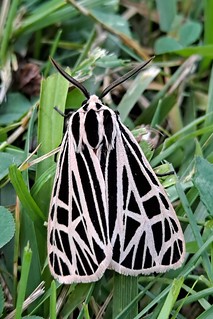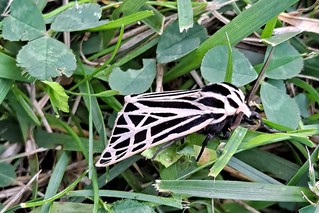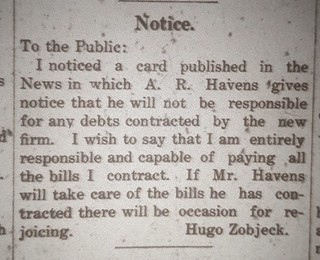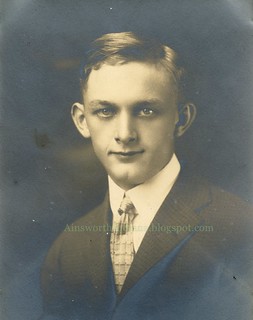When we left off with the
Harms 73rd Avenue farm, Charles Chester had just bought those 80 acres.
That was August 1856. Some seven months later, in March 1857, Charles and his wife, Mary, sold the land to Luther and Sarah Smith for $900. The purchase was financed with six promissory notes coming due at intervals over the next six years, their payment secured by a mortgage.
 (Click on image to enlarge)
(Click on image to enlarge)
Image courtesy of the Eldon Harms family.
The Smith family and the Chester family had been neighbors for a few years before this sale. If we look at
Early Land Sales, Lake County, we find that in May of 1850, Charles and Mary Chester bought the northwest quarter of Section 17. The following year, Jacob and Hannah Smith (Luther's parents) bought the adjacent northwest quarter of the northeast quarter — that is, the land where someday Henry Chester would build his
brick farmhouse.
 (Click on image to enlarge)
(Click on image to enlarge)
This image is from the 1874 Plat Map.
The Smiths had been in Ross Township early enough to be counted in the
1850 Census: Jacob, 49, a native of Connecticut; his wife, Hannah, also 51, born in New York; and their children, Luther and Charles L. (16 and 13, respectively, and both born in Ohio), plus a 19-year-old woman named Emma Bevins, of Canadian birth. They were recorded with only one intervening entry between them and
the Chester family, so perhaps the Smiths were renting farmland nearby.
In 1854, Luther Smith married Sarah Maxwell (
Indiana Marriage Collection), who was only about 15 years old.
[1]
Then in 1857 comes this sale to Luther and Sarah of the Chester 80 acres along Randolph Street. And that is where the
1860 Census finds them, with their children, Emma (5), Albert (2), and Sarah (10 months). Also in the home were Luther's parents, Jacob and Hannah.
[2]
The mortgage on the land was cancelled in 1861, a year before the final promissory note was due. It may have been paid off early with money raised through what happened in 1859: Luther gave his parents a life-long lease on the land, for which they paid him $600.
 (Click on images to enlarge)
(Click on images to enlarge)
This image and the images below courtesy of the Eldon Harms family.
In January 1865, Luther enlisted in the Union Army. By August of that year he was at home (not discharged yet, so perhaps on leave, possibly due to poor health). On August 10, he
died.
He had made no will, and it seems that for a few years, his survivors went on farming that land together peaceably, not even seeking to have Luther's estate probated. But in 1868, something began to stir, and that's when the county court finally appointed an estate administrator.
 (Click on image to enlarge)
(Click on image to enlarge)
Image courtesy of the Eldon Harms family.
And in 1869 Jacob and Hannah sued the estate for the return of the $600 they had paid Luther ten years earlier.

The 1859 transaction between them and their son, they said, wasn't just a lease for $600. It was a promise of a home: "these claimants were to live with said Luther Smith upon said premises and help to till the same and to share the benefits thereof throughout their natural lives," and if ever Luther sold the farm out from under them, Jacob and Hannah would get their $600 back. But that provision was not included in the lease "through a misunderstanding of the Justice [of the Peace] drawing said agreement, and through their own ignorance of the modes of doing business and the force of written contracts."
Reading between the lines of the last paragraph, it sounds as if, in August of 1865, Luther did not expect to recover from his sickness — he and his parents "talked over" these arrangements, "and the final understanding was that in the event of his death the farm must be sold." He did die, as we know, but the farm wasn't sold, and his parents went on without their $600 for several years.
I wonder if Sarah — still a young woman — was getting restless around 1868, wanting to sell the farm, take her share of the money, and move on with her life somewhere else.
A sympathetic court decided that the lease of the farm should be cancelled, and the $600 returned to Jacob and Hannah.

The estate administrator then petitioned the court to be allowed to sell the farm, and summarized the estate:

After the required publications to advise potential buyers, the sale went forward. And Jacob and Hannah bought the farm.

Luther's widow and four minor children received a total of $506.22 from the estate (about $10,000 in today's money).

The estate administrator duly conveyed the land to the elder Smiths.

Sarah may have moved on with her life, but unfortunately she did not have much life left. According to the penciled note in the bottom margin of page 6 of the abstract, above, "Sarah P. Smith died Aug 9th 71." Perhaps that was written circa 1896, when Henry and Johanna Harms were buying the land. But a statement from 1878 says approximately the same thing:

By 1877, Jacob and Hannah had died too.

Concerning the four minor heirs of Luther's estate, someone jotted notes on the abstract, again probably circa 1896: Emma, Elbert, and Ambrose were dead; Adna was living in Denver (where he is now
buried). The little Sarah from the 1860 census is unaccounted for; she may have died in infancy. The rest of Luther's survivors named in the abstract are a mystery to me — their lives, their deaths, their final resting places.
Luther Smith himself is buried in the
Woodvale Cemetery, but he is not alone. His and Sarah's son rests there too — a two-month-old infant, named
Jacob for his grandfather.
_______________
[1] I don't know much about Sarah's family of origin. Her marriage is the earliest record I can find of her locally.
[2] The other son, Charles L., was not in the household and in fact I can't find him in 1860, but we will hear from him again.




















